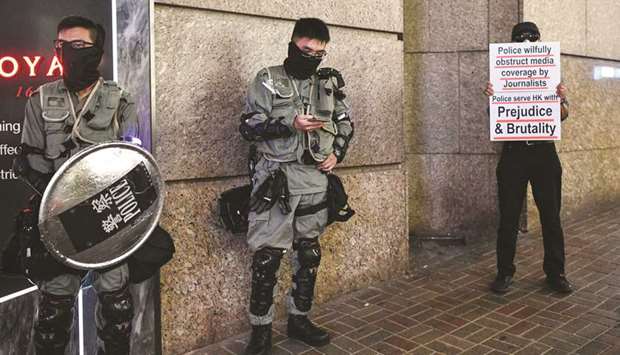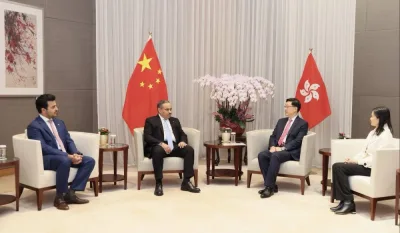Hong Kong democracy activists donned Halloween masks lampooning the city’s pro-Beijing leaders yesterday, defying an emergency law that bans face coverings and sparking renewed clashes with police.
Online forums used to organise the largely leaderless movement encouraged supporters to wear Halloween-themed masks as police warned they would force revellers to remove outfits and facepaint if they engaged in protests. Small flashmob rallies broke out in multiple locations yesterday evening.
The new protests come as official figures released yesterday showed the city has plunged into a technical recession for the first time since the global financial crisis over a decade ago. At Victoria Park, around a hundred protesters gathered for an unsanctioned march to a popular nightclub district that had been surrounded by riot police. Many wore outfits poking fun at the city’s leadership.
Yan Lee, an accountant in her 50s, wore a mask that combined the face of justice secretary Theresa Cheng with the Disney villain Maleficent. “For months she has done nothing for Hong Kong but defend the authorities,” she told AFP. Another protester, who gave her surname as Loo, had painted her face in the style of Batman’s nemesis, The Joker.
She said she was inspired by the recent Hollywood film that traces The Joker’s origin story as he launches a revolution against Gotham City’s elites. “The idea that everyone owns the spirit to fight touched me a lot,” she said. Across the harbour in Prince Edward district, the protests had a more familiar and less satirical feel, with police firing tear gas and chasing hardcore protesters who had taken over roads. Activists were marking two months since police were filmed beating protesters in Prince Edward subway station, one of multiple incidents this summer that have fanned hostility towards the force.
Hong Kong has been upended by nearly five months of huge, often violent, pro-democracy protests in which participants routinely use masks to hide their identities and protect themselves from teargas and pepper spray. Earlier this month city leader Carrie Lam invoked colonial-era legislation for the first time in more than fifty years to outlaw face coverings at rallies.
The move was seen as a watershed legal moment for the city since its 1997 return by Britain to China – but the ban has done little to stop the protests or dissuade people from wearing masks. Police released a video on Facebook warning protesters not to use Halloween as an excuse to hold rallies, and vowed to arrest people who refused to remove their masks when requested to do so.
Earlier yesterday, activists went to court to challenge the emergency law. “This is a duel between the rule of law and totalitarianism,” lawmaker Dennis Kwok told reporters outside the High Court at the start of a two-day hearing. The sweeping 1922 emergency law was passed by then colonial master Britain to deal with striking workers and allows the city’s leader to make “any regulations whatsoever” in a time of emergency or public danger.
It was last used in 1967 by the British to help suppress Maoist-backed leftist riots that raged for nearly a year and killed some 50 people. Lam’s use of the law was controversial because it bypassed the Legislative Council, the partially-elected chamber that approves Hong Kong’s laws. Critics said the move undermined the city’s reputation for being a dependable business and legal hub at a time of growing concern over Beijing’s control of the city. The protests were initially sparked by a now-abandoned plan to allow extraditions to the authoritarian mainland. But they snowballed into a wider democracy and police accountability movement.
Increasingly violent clashes have broken out between hardcore protesters throwing petrol bombs and bricks at police who are responding with ever increasing amounts of tear gas and rubber bullets. The clashes have hammered the city’s once-solid reputation for stability and has further battered an economy that was already reeling from the US-China trade war.
Lam and Beijing have shown little appetite to meet protester demands, or to offer a political solution. Instead they have opted to wait out a movement that has remained stubbornly resilient and appears to maintain significant public support despite the economic hardship.

A man holds a protest poster next to policemen in the Lan Kwai Fong area as people celebrate Halloween in Hong Kong yesterday.


